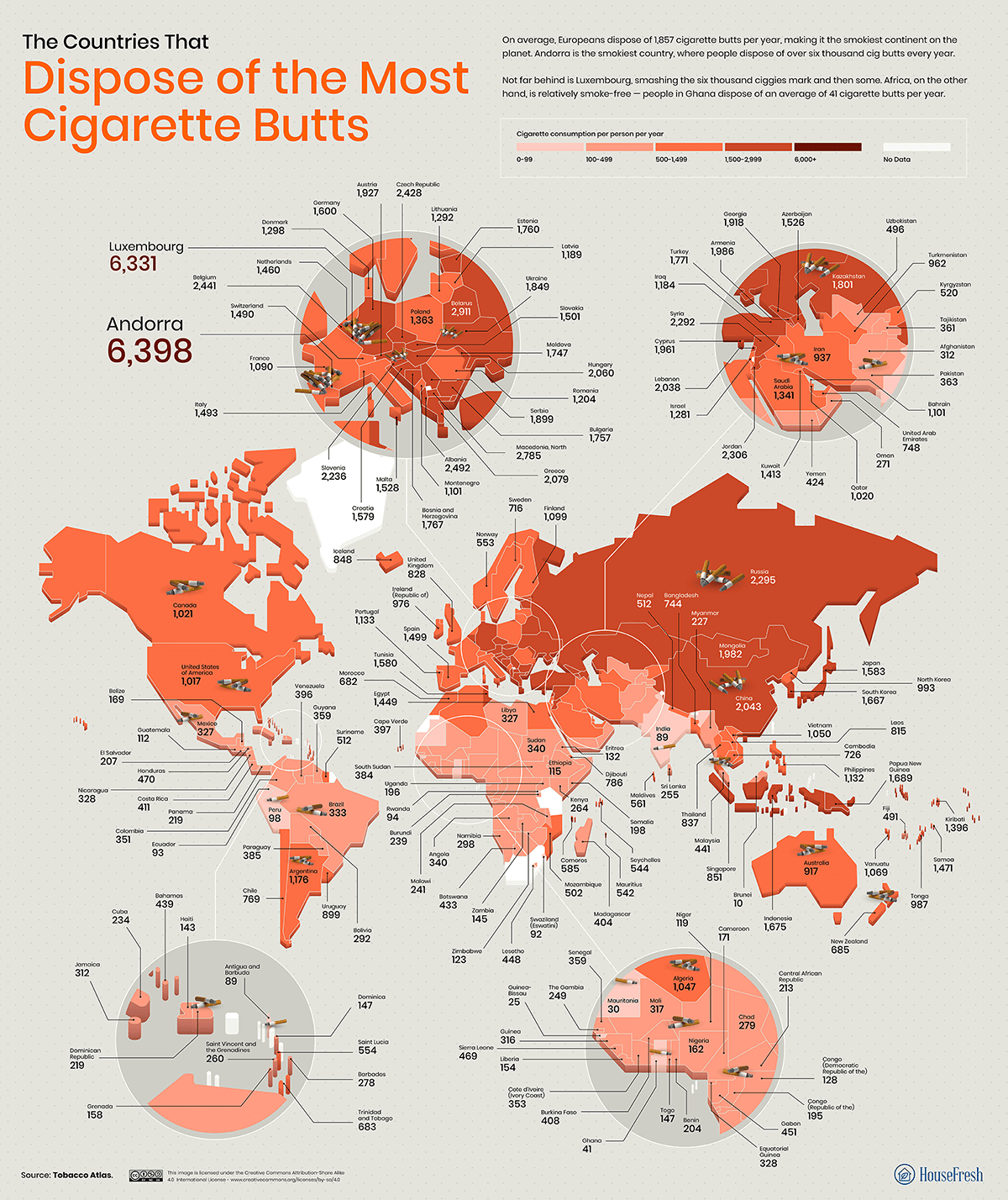Cigarettes are killing our planet.
We smoke 4.5 trillion cigarettes every year – enough to reach Saturn and back. But we don’t send the butts to Saturn. We crush them under our shoes.
To better understand the scale of the issue, HouseFresh crunched the numbers to visualize the human-made structures that would get crushed in a minute, day, week, month, and year of cigarette butts – from an Olympic boxing ring to New York’s Central Park.
Europeans leave the most cigarette butts per person
So, who’s dropping all those butts? In Andorra and Luxembourg, the average consumption is over 17 cigarettes a day or 6,000/year – and that’s averaged out across the whole population, including non-smokers.
Nearly half (46.6.%) of Andorra’s high school children smoke at least occasionally, which is a bad start. Tobacco is a major crop in Andorra, and smoking culture is prevalent. This also means that ‘cigarette tourism’ is high in the country, with consumption figures bumped by visitors stocking up on cheap packs. The country has only recently banned smoking in bars and cigarette advertising.

European countries account for seven of the top 10 consumers and 32 of the top 50. Canada (1,021/year) has the highest smoking rate in North America, but the US (1,017) is almost tied. Up to 40% of items collected in American litter clean-ups are butts, which are the most littered item on US roads, drains, parks, and beaches.
Pacific islands have highest smoker rates
Is it just a few bad apples or a national habit? Next, we looked at smoking rates by percentage of population. We found that Pacific islands Nauru, Kiribati, and Tuvalu have the highest smoking rates in the world, with more smokers than non-smokers in both Nauru and Kiribati. This corner of the world, including Oceania and parts of Asia, has high smoking rates in general.
There are moves to reduce tobacco consumption in the Pacific, although these are health initiatives rather than environmental ones. As with Andorra in Europe, tobacco cultivation and smoking culture go hand in hand on some Pacific islands and south Asian countries. And there is a lower taboo against female smoking among Pacific islanders than in other developing nations, pushing up the overall rate.

Europeans still put in a good effort, with more than 30% of the population in 12 European countries hard at work producing cigarette butts. In the States, just under a quarter (24.3%) smoke – the world’s sixtieth highest rate. African countries generally have the lowest smoker rates – but these rates are rising, with one in five adolescents now sparking up.
The environmental impact of cigarette butts
Cigarette butts are made of plastic: Cellulose acetate. They also contain chemicals and heavy metals. Guess what: they don’t biodegrade. It is possible to recycle them – but most end up on the streets, in the sea, and in the landfill.
Cigarette butts stifle plant growth. For example, their presence reduces grass reproduction by 10% and the root biomass of clover by 57%. Not good for a planet fighting climate change. When a pet ingests nicotine, it can cause “excessive salivation, excitement, tremors, vomiting, lack of coordination, weakness, convulsions, respiratory failure and even death.” One butt in a liter of water will kill half the fish.
But it’s not one pet or a liter of seawater that we’re coping with: it’s 4.5 trillion cigarette ends. And smokers have made a habit of the ‘flick’ that’s as hard to kick as the smoke itself.
In one minute, humans dump 8.5 million cigarette butts, equal to 50 cubic meters – or an Olympic boxing ring.

In one day, we dump 12.3 billion cigarette butts, equal to 72,522m3 – a bit bigger than the Lincoln Memorial.

In one week, we dump 86.4 billion cigarette butts – that’s 509,050m3 or TWO White Houses.

In one month, we dump 375 billion cigarette butts, which equals 2,205,882m3 or one Capitol Building.

In one year, we dump 4.5 TRILLION cigarette butts, equaling 26,470,588m3 and enough to cover New York’s Central Park.

How to stub out stubbing it out
It is estimated that the US spends $4 billion per year dealing with cigarette litter. This total alone should raise eyebrows, but the cost is more severe than a dollars-and-cents figure suggests. Cigarette butts start forest fires and choke animals. They poison sea life and inhibit plant growth.
In addition to ramping up human health-oriented anti-smoking schemes, we need efforts to deal with the butts that continue to get produced. These efforts can include:
- Developing and mandating alternative, biodegradable filters.
- Punishing/incentivizing big tobacco producers to initiate change.
- Mainstreaming viable butt disposal policy and infrastructure (laws and recycling facilities).
- Developing a greater sense of collective community responsibility in schools.
- Support the use of technology to deal with pollutants in the air caused by smoking
- It’s your school/workplace/constituency: are you ready to kick up a stink?
Methodology
Data for cigarette butt cubic meter volume comes from Omni Calculator and is based on 170 cigarettes filling 1 liter of volume. Quantity of cigarette butts littered globally per year comes from Science Direct.
Cubic meter volume of objects and landmarks calculated from measurements were sourced from Wikipedia and the Google Maps distance measurement tool. Volumes of buildings (factoring in building/object shape) were compared to cubic meter volume of cigarette butts littered per year, month, week, day, and minute.
Global smoking rates were sourced from the World Bank. Global cigarette consumption sourced from Tobacco Atlas.





